
深度学习模型,特别是卷积神经网络(cnn),在训练时会针对特定的输入图像尺寸进行优化和结构设计。这主要体现在以下几个方面:
因此,当YOLOv8模型在512x512的图像上训练后,在2145x1195这样尺寸差异巨大的图像上直接推理时,就会出现严重的性能问题甚至失败。解决方案是在将图像送入模型之前,将其调整为模型期望的输入尺寸。
图像尺寸调整是深度学习模型推理前重要的预处理步骤。以下将分别介绍在PyTorch和TensorFlow框架中如何实现这一过程。
在PyTorch中,通常使用torchvision.transforms模块来处理图像。
import torchvision.transforms as transforms
from PIL import Image
import torch
def preprocess_image_pytorch(image_path: str, desired_size: tuple = (640, 640)) -> torch.Tensor:
"""
使用PyTorch对图像进行预处理(尺寸调整、转换为Tensor)。
Args:
image_path (str): 图像文件路径。
desired_size (tuple): 目标图像尺寸 (宽度, 高度)。应与模型训练时的输入尺寸一致。
Returns:
torch.Tensor: 预处理后的图像张量。
"""
try:
image = Image.open(image_path).convert("RGB") # 确保图像为RGB格式
except FileNotFoundError:
print(f"错误:文件未找到 - {image_path}")
return None
except Exception as e:
print(f"加载图像时发生错误:{e}")
return None
# 定义图像转换步骤
# transforms.Resize: 将图像缩放到指定尺寸
# transforms.ToTensor: 将PIL Image或numpy.ndarray转换为Float Tensor,并归一化到[0.0, 1.0]
transform = transforms.Compose([
transforms.Resize(desired_size),
transforms.ToTensor(),
# 如果训练时进行了标准化,这里也需要添加:
# transforms.Normalize(mean=[0.485, 0.456, 0.406], std=[0.229, 0.224, 0.225])
])
resized_image_tensor = transform(image)
return resized_image_tensor
# 示例用法
# image_path = "path/to/your/large_image.jpg"
# model_input_size = (640, 640) # 假设YOLOv8模型期望的输入尺寸
# preprocessed_image = preprocess_image_pytorch(image_path, model_input_size)
# if preprocessed_image is not None:
# print(f"预处理后的图像张量形状: {preprocessed_image.shape}") # 预期输出: torch.Size([3, 640, 640])
# # 接下来可以将 preprocessed_image 送入YOLOv8模型进行推理
# # results = model(preprocessed_image.unsqueeze(0)) # 添加批次维度在TensorFlow中,可以使用tf.image模块来进行图像处理。
import tensorflow as tf
from PIL import Image
import numpy as np
def preprocess_image_tensorflow(image_path: str, desired_size: tuple = (640, 640)) -> tf.Tensor:
"""
使用TensorFlow对图像进行预处理(尺寸调整、转换为Tensor)。
Args:
image_path (str): 图像文件路径。
desired_size (tuple): 目标图像尺寸 (宽度, 高度)。应与模型训练时的输入尺寸一致。
Returns:
tf.Tensor: 预处理后的图像张量。
"""
try:
image_pil = Image.open(image_path).convert("RGB") # 确保图像为RGB格式
except FileNotFoundError:
print(f"错误:文件未找到 - {image_path}")
return None
except Exception as e:
print(f"加载图像时发生错误:{e}")
return None
# 将PIL Image转换为TensorFlow张量
# 注意:tf.image.resize期望输入是float类型,且像素值范围通常是[0, 255]或[0, 1]
image_tensor = tf.convert_to_tensor(np.array(image_pil), dtype=tf.float32)
# 调整图像尺寸
# tf.image.resize 默认使用双线性插值
# size参数是 (height, width)
resized_image_tensor = tf.image.resize(image_tensor, size=desired_size)
# 归一化像素值到 [0, 1] 范围 (如果模型训练时是这样)
resized_image_tensor = resized_image_tensor / 255.0
# 如果训练时进行了标准化,这里也需要添加:
# mean = tf.constant([0.485, 0.456, 0.406], dtype=tf.float32)
# std = tf.constant([0.229, 0.224, 0.225], dtype=tf.float32)
# resized_image_tensor = (resized_image_tensor - mean) / std
return resized_image_tensor
# 示例用法
# image_path = "path/to/your/large_image.jpg"
# model_input_size = (640, 640) # 假设YOLOv8模型期望的输入尺寸
# preprocessed_image = preprocess_image_tensorflow(image_path, model_input_size)
# if preprocessed_image is not None:
# print(f"预处理后的图像张量形状: {preprocessed_image.shape}") # 预期输出: tf.TensorShape([640, 640, 3])
# # 接下来可以将 preprocessed_image 送入YOLOv8模型进行推理
# # results = model(tf.expand_dims(preprocessed_image, axis=0)) # 添加批次维度YOLOv8模型在不同尺寸图像上推理失败的根本原因在于其内部结构对输入张量尺寸的严格要求。通过在推理前对图像进行正确的尺寸调整(并匹配训练时的其他预处理步骤,如归一化和长宽比处理),可以有效地解决这一问题,确保模型在各种尺寸图像上都能稳定且准确地进行目标检测。理解并实施正确的图像预处理是部署深度学习模型时不可或缺的关键环节。
以上就是YOLOv8推理中的图像尺寸适配:原理与实践的详细内容,更多请关注php中文网其它相关文章!

每个人都需要一台速度更快、更稳定的 PC。随着时间的推移,垃圾文件、旧注册表数据和不必要的后台进程会占用资源并降低性能。幸运的是,许多工具可以让 Windows 保持平稳运行。




Copyright 2014-2025 https://www.php.cn/ All Rights Reserved | php.cn | 湘ICP备2023035733号